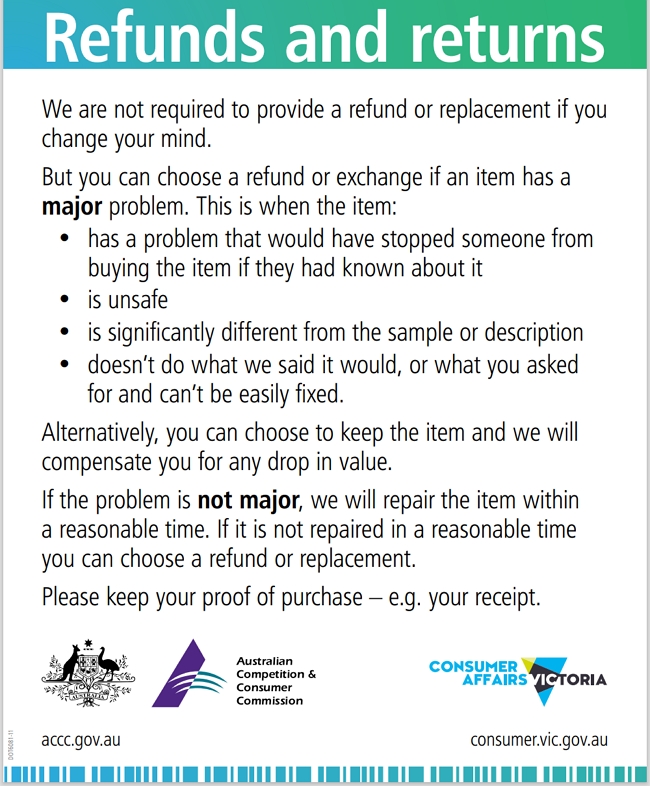
Customers Return their Purchases to your shop
There is currently an avalanche of customer returns.
Although I have not seen any Australian figures in the US, studies by the National Retail Federation, the largest retail trade association in the world, indicated that 10.6% of all retail sales in the United States were returned in 2020. Roughly 5.9% were found to be fraudulent, which was the most troubling.
There were, I am sure, more fraudulent claims than 5.9%. Almost every retailer I know has a story about fake receipts or returned goods for which they were not purchased.
Common reasons for returns and some ideas:
Unwanted presents
Presents bought by people who don't want them are a big problem, especially around this time of year.
Try offering something else.
Change of Mind
Customers often buy something, decide it's too complicated for them, or don't want it and return it.
Legally, you are not required to refund here; yet it is frequently difficult to enforce your rights there.
A product that is damaged or defective.
One worrying aspect of the situation is that many retailers occasionally sell defective goods at significantly reduced prices. They concede that they are imperfect and thus sell it with no guarantees and ASIS. Legally, I don't think this is right. If you do it frequently, consider looking into this situation.
Agency problems
Incorrect product received
If you are the agent for the item, this frequently occurs; try contacting the supplier to ensure that the correct product is sent. You may also have a claim against the supplier if this is not your fault; you have done everything right, it is not your fault the wrong goods were sent.
Put procedures in place to reduce this issue in the future and prevent this from happening again.
To late
Another example is when a customer needed something immediately, but it never showed up, so they went elsewhere and did not need it anymore.
In the future, attempt and make a method where you can supply your clients with precise delivery info about the specific time for delivery.
Fraud
A well-known example is "Wardrobing", which occurs when a customer purchases an item to return it after a brief period of use. It is difficult to stop this fraudulent practice.
You must have proper procedures for handling returns.
Opportunity to fix the problem
If you handle returns professionally, customers may have a positive impression of your business and be more likely to shop with you again. If you mess up, you could lose them forever so returns can be a chance to provide better customer service, offer more products or services, and interact with them. Even if it doesn't help this time, it might result in better future results.
Having a clear return policy
A simple return procedure would be ideal if you had a clear return policy. I advise posting a sign outlining your shop's policy somewhere.
Examine item
Well, it looks like the item is coming back; you better check what you are getting, so examine the product for any indications of abuse or damage.
Make sure the receipt is authentic.
Nowadays, it is all too easy to produce forged receipts and confirming the time and location of an item transaction should be simple with your POS system.
Also, I am aware of instances in which individuals have retrieved old receipts from trash cans in shopping centres. Then entered a store, grabbed the item and requested a refund at the counter. The receipt is valid here, but it's fraud.
The only solution here is that you have a high-quality security camera.
Payment procedure
Ensure that the method of payment is the one refunded. If they paid using VISA, you refund with VISA. If they paid with EFTPOS, you refund them with EFTPOS, and so on.
If you don't, one of the risks here is known as a double chargeback. A person who paid with VISA receives a cash refund and then files a refund claim with VISA. You must then show that you paid in cash.
Also, record the customer's identity before issuing a cash refund. I'd ask them to sign as well.
Conclusion
Managing retail returns is crucial because they can affect customer satisfaction and loyalty. Customers today expect fast, free, and easy returns. Even though retail returns can be costly, a poor returns experience can decrease customer loyalty. Time and money can be saved, customer loyalty can be increased, and opportunities for engagement and upselling can be created by effectively managing the return.


